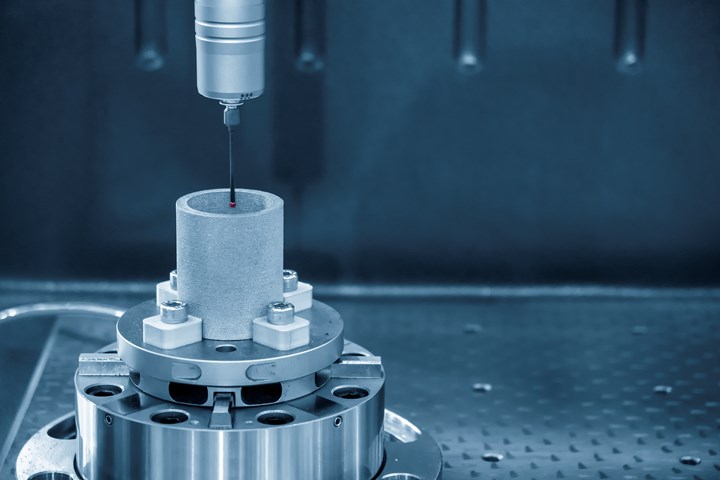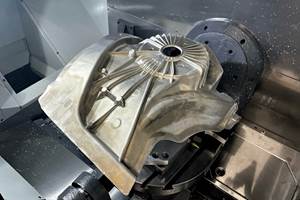Parts and Programs: Setup for Success
Tips for program and work setups that can simplify adjustments and troubleshooting.
Reader Question:
When looking through CMM reports, some of the necessary sizing adjustments seem obvious while some of the positional adjustments are not so simple. We tend to struggle correlating these issues to the CNC process. Can you provide some thoughts on program and work setup that can simplify adjustments and help us with troubleshooting?
Miller’s Answer:
Whenever faced with a new project, all machinists take on the same task of figuring out how we will to hold a part and with how many setups. The absolute best way to ensure a successful setup is to design the workholding such that the print datums rest on the hard stops of your fixture. While this may seem obvious, it often competes with other process goals like simplicity. However, it comes with important benefits. First, the datums of the part rest against a solid, repeatable, non-moveable location within the machine. Therefore, on longer part runs, we can skip additional probing. Secondly, we now have a point of accountability in the process. If you see positional issues, you can reconfirm the hard datum locations in the machine. If its loosened or moved, then it is an obvious fix. This is much better than chasing the CNC program or chasing work offsets adjustments to no avail. If that hard datum did not move, then you know to reconfirm the program or look elsewhere like thermal shift or a missed tool adjustment.
If you are unable to locate on the hard datums, then the next best option is what I refer to as a soft datum. This means utilizing the probe, and calculating where the datum theoretically exists, or using a proxy datum. A proxy datum can rest on a hard stop of some type, or it can be probed. In either case, it must be maintained to a tight tolerance back to the real datum such that if the proxy datum position is in spec, the normal datum is also in spec.
In the case of first operations, uneven stock conditions like forgings or castings require locating on the hard datums as a means of staying centered to the cast or forged shape, which is often crucial for final part performance. This matters less for billets as there is generous stock all around the part. For secondary operations and beyond, locating on features machined in the previous operations is a best practice unless a proxy is required.
After determining the most optimized strategy for locating the part, the next step is programming in a way that compliments this strategy. I always program such that the zero point of the program is the intersection of the primary, secondary and tertiary datums of the part print. In the case of multisided operations (four- or five-axis), this means unique work offsets for each face of the part, or the use of Dynamic Fixture Offset such that the zero point moves with the part as it rotates. I always opt against using a fictious point in space like the corner of a vise or the center of a rotary axis for programming. While it may be convenient at the time, it greatly hurts the ability to troubleshoot because if you’re using a known position on the print, the resulting numbers in the CNC program will match the numbers used on the part print. The machinist can then verify feature locations and depths back to the part print before cutting a part or after the fact for troubleshooting. If there is a discrepancy in the two, it could be a problem with the 3D model or a simple misnomer on the part print, which can be verified with the customer. By programming from a point which does not exist on the part, this troubleshooting becomes quite cumbersome with multiple sources for error or additional math needed to verify each piece of the process.
This problem with multiple sources of error may not seem as important for a single part, but it compounds greatly as we try to utilize multiple parts on a nested fixture. For nested operations, I utilize more work offsets for each nest as needed such that each nest’s programs match the part print. If a single fictious point is used for all nests, then program numbers will not match from nest to nest, and there is zero flexibility to tune each nest individually as needed. With unique offsets for each nest, the process can absorb some error to each other and be tuned through simple offset adjustments that are 1:1 with the CMM report. With a single offset in charge of an entire fixture of parts, your only option is to shift the part virtually in the CAM program, repost the program and hope for the best.
As a final point, position results from the CMM rely on more than just simple coordinates. The CMM relies on the rotation of your primary, secondary and tertiary planes and how each plane is pointed to determine zero. This is called the alignment. Issues that impact the alignment of the part in the CNC , such as non-square setups or sitting on a chip when you locate the part, will impact the results at the CMM and can’t be adjusted for with simple offset moves. Care should be taken during the workholding setup for straight datums and during clamping for clean locators.
In your upcoming projects, continue the work of optimizing for fewer setups, but be more thoughtful with the datum structure and matching the intent of the print. Taking a few extra steps during planning to nail these details — as well as where you will set work offsets and program zero — pays dividends in the quality department. By taking on this additional step, you can make better process decisions in CAM long before making a chip to enable better first-pass quality, simpler adjustments and troubleshooting.
Related Content
Modern Bar Feeds Bring New Life to Automatic Swiss Lathes
Cam-actuated Swiss lathes are still the fastest way to process many parts. By adding modern bar feeders, this shop has dramatically improved their utilization with the ability to work unattended, even in a lights-out environment.
Read MoreFixturing Castings Made Simple Through Adhesive Workholding
When a casting proved too malleable for traditional gripping, Thomas/Euclid Industries adopted — and succeeded with — Blue Photon adhesive workholding.
Read MoreCustom Workholding Principles to Live By
Workholding solutions can take on infinite forms and all would be correct to some degree. Follow these tips to help optimize custom workholding solutions.
Read MoreMachining Vektek Hydraulic Swing Clamp Bodies Using Royal Products Collet Fixtures
A study in repeatable and flexible workholding by one OEM for another.
Read MoreRead Next
3 Mistakes That Cause CNC Programs to Fail
Despite enhancements to manufacturing technology, there are still issues today that can cause programs to fail. These failures can cause lost time, scrapped parts, damaged machines and even injured operators.
Read MoreThe Cut Scene: The Finer Details of Large-Format Machining
Small details and features can have an outsized impact on large parts, such as Barbco’s collapsible utility drill head.
Read More


























